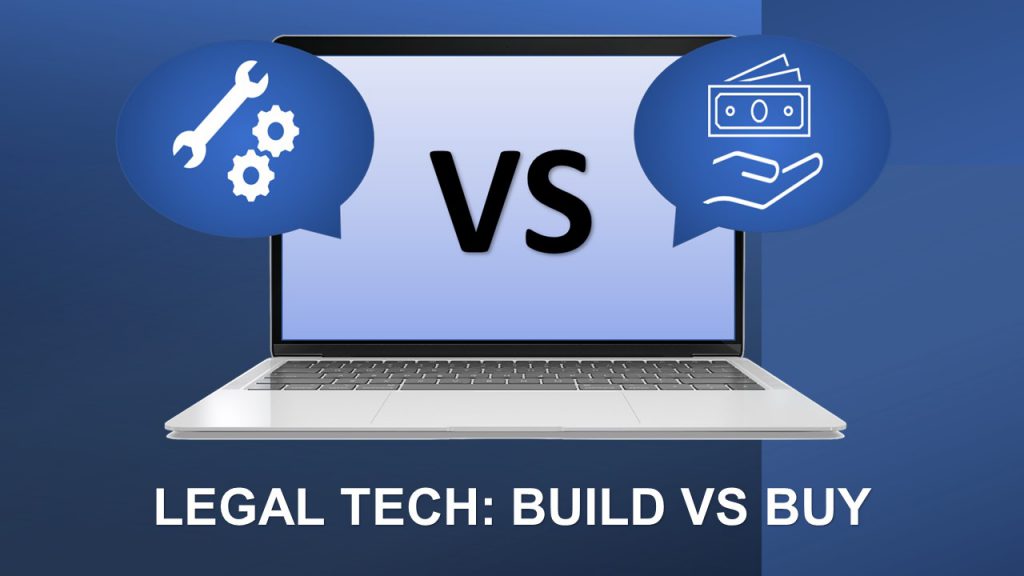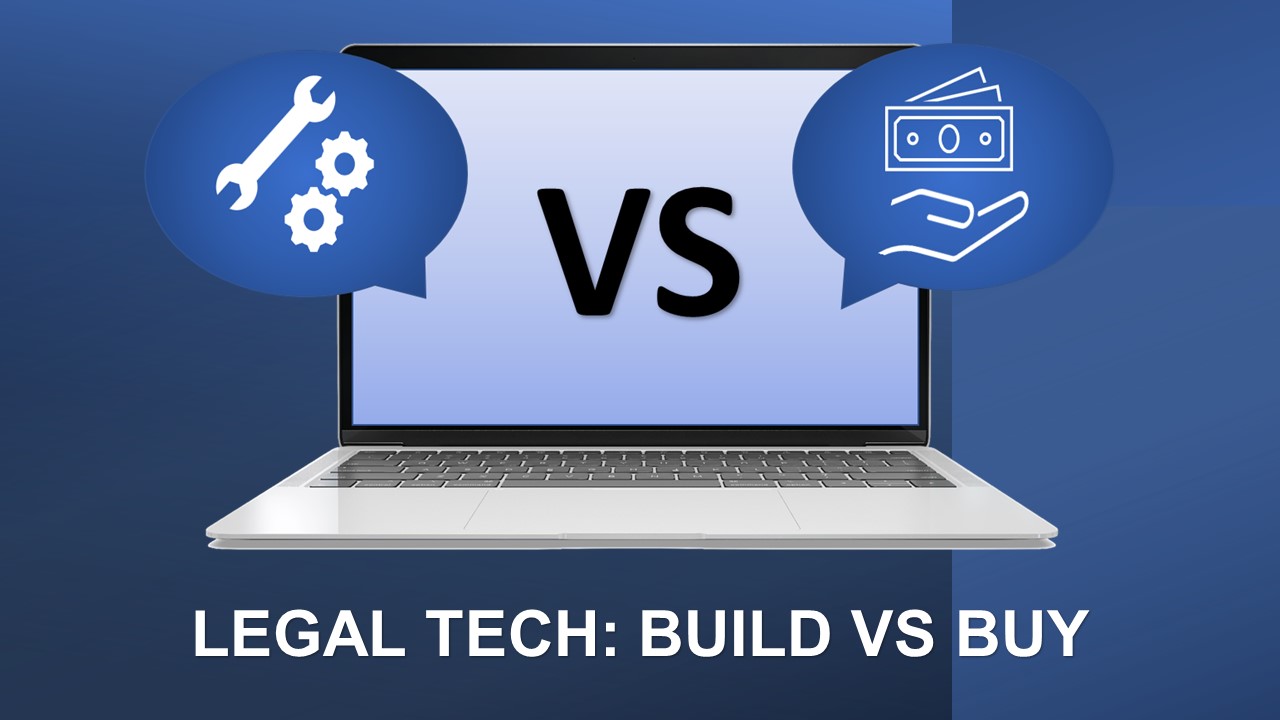
Where technology can enable a team to deliver the same value to their organisation at a lower cost – or deliver additional value that justifies any additional cost – investing in tech should arguably be a ‘no brainer’.
And yet – where legal technology is concerned – buying software is sometimes viewed as a last resort, to be considered only if there is no way to build something internally or ‘piggy-back’ off something another team is already using.

Where technology can enable a team to deliver the same value to their organisation at a lower cost – or deliver additional value that justifies any additional cost – investing in tech should arguably be a ‘no brainer’.
And yet – where legal technology is concerned – buying software is sometimes viewed as a last resort, to be considered only if there is no way to build something internally or ‘piggy-back’ off something another team is already using.
In some cases, there may be something specific about the way the company works which means one of those routes makes sense.
Or budget constraints might be such that it is the only option, and the conclusion (not always correct!) is that ‘something is better than nothing‘.
The key, however, is to ensure that – whatever decision is made – it is made with open eyes, having properly weighed the benefit of any apparent cost savings against the potential downsides of a DIY approach.
In this article, we set out some of the issues you should consider when making this analysis.
Often, the assumption is that a DIY solution will be cheaper.
However, while there may* not be any new upfront or recurring invoices to pay, ‘there ain’t no such thing as a free lunch’.
How many lawyers, IT professionals and other colleagues will need to be involved in scoping, building, testing, implementing, and supporting a solution?
How much will their time cost the company over the design/implementation phase and beyond?
You may find that these hidden costs quickly exceed the cost of a third party legal tech solution.
There are also non-monetary costs. What other projects and priorities would you be pulling your legal team, IT professionals and others away from to create your solution
(*Most DIY solutions will be at least partly based on connecting a handful of products to assemble the feature set you need. In some cases, these might be ‘sunk costs’ e.g. enterprise software you already have licenses for but you might find you also need to pay for additional software if you’re requirements go beyond relatively basic/generic features.)
Where a DIY solution is concerned, there will be an inevitable trade-off between features/utility and speed of implementation.
For instance, creating a basic legal request form using Microsoft or Google forms might be a relatively quick option. However, it will fall far short of a comprehensive legal front door that seamlessly integrates “legal ticketing” with other essential elements for an efficient and well-rounded workflow management and automation system.
The more features you introduce to a DIY solution the more time will be needed. There is also an increased risk of reinventing wheels, tackling challenges that have already been solved by multiple legal tech vendors!
If you find a legal tech solution that meets your needs, it will work ‘out of the box’ and the vendor will be able to help you get set up and realising the benefits as quickly as possible.
As such, building a solution (whether from scratch or via adaptation/integration) may come with a very real opportunity cost in terms of lost time that could have been spent focussing on key legal deliverables while reaping the benefits of a ready-made solution, rather than getting bogged down in a project to create a DIY solution.
Once you have a solution in place, who will maintain it
Will your legal team have the necessary knowledge and skills to identify and fix any issues themselves?
Or would you be reliant on your IT team?
If the latter, can you be sure that they would have time to dedicate to the legal team’s ongoing needs – particularly if they invested a lot of time and effort in helping to scope and build a solution in the first place?
Could your team afford to raise a ticket with IT and wait for days or weeks (or longer?) for a fix? What risks would this create for the company
By contrast, a dedicated legal technology SaaS (software as a service) solution will be supported by the vendor and this support will (or should!) be backed up with robust contractual commitments around up-time and response times etc.
Where a DIY solution is based on integrating several separate solutions (often the case), this can also cause issues. What happens if one of those components fails or is discontinued? Upgrades and changes to individual component solutions can also cause integrations to break down.
Compare that to being able to rely on a single solution, provided by a single supplier whose primary focus (and commitment) is to provide a robust and reliable solution to in-house legal teams.
Your DIY solution is unlikely to be perfect right out of the gate and your environment and needs will inevitably evolve over time in any case.
Where changes or new feature requirements are identified, how would these be actioned
Having to rely on internal IT resources will potentially mean that it’s difficult to get the level of support needed to keep up with such requests or requirements.
And, again, your ability to make changes or introduce new features will be constrained by limitations of the underlying components you use to create your DIY solution (e.g. it’s unlikely that Microsoft will tweak or change a feature just for you no matter how charming and persuasive you are!).
Legal technology vendors will typically be far more willing (and able) to accommodate changes and/or new feature requests – particularly where such developments would be likely to benefit other customers and make the product more attractive to prospects.
Similarly, by buying a dedicated legal technology product, you will automatically benefit from improvements being made in response to user feedback from a broad pool of your peers as well as those which are part of the supplier’s ongoing product development roadmap.
Building a solution in-house will typically mean investing a significant amount of time and resources before there is a product you can test.
If the resultant solution is not up to scratch, then – as mentioned above – securing further investments of time, money, and resources to fix/improve it might not be easy.
There may also be political sensitivity around criticising a product that was built internally.
If the solution ultimately isn’t fit for purpose – it might be difficult for all concerned to accept this fact, write off the effort that went into the project and move on.
At that point, securing investment to invest in a dedicated third-party legal tech solution would likely be very challenging.
If these factors result in persisting with a subpar solution, you may discover that your intended goals remain unachieved, or worse, that the situation has deteriorated. For instance, the new system may actually impede workflows rather than enhancing them.
If the solution cannot do what needs to be done – or if the user experience is too painful and clunky – the most likely outcome is that people will find a way to avoid using it altogether.
By contrast, a dedicated legal technology platform is ready ‘out of the box’ and you can take advantage of multiple opportunities to assess, test and compare available solutions through demonstrations, free trials, and proofs-of-concept before committing.
Furthermore, even if your chosen solution ultimately proves to be unsatisfactory, getting out of a SaaS contract is relatively quick and expensive and offers an easier (and less politically charged) way to change direction as compared to the DIY option.
A DIY product will not always be cheaper or quicker to implement and there are several risks and challenges to bear in mind around hidden expenses, time constraints, support limitations, and potential quality issues.
Buying a ready-made solution can offer more certainty around cost, capabilities, and timelines. Building a relationship with a good vendor will also provide peace of mind when it comes to ongoing support as well as benefits around future product development.
As we mentioned at the start, the key takeaway is to ensure you take such factors into account and make a well-informed decision about which route to pursue.
If you’re exploring legal technology for your team, you might like to check out some of our related blog posts:
Introducing a Legal Front Door
Legal Ticketing: 6 tips for success
What is contract automation and what are the benefits?
Panel Management: the prize is in the process
Self-service technology: 3 ‘win-win’ use cases for in-house legal teams
No-code automation: legal workflows
If you want to learn more about how Tabled’s legal operations platform could help your team please get in touch or request a demo using the sign up form below.